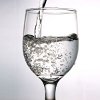 Water is the single most important resource for the human body. Water is the most essential nutrient involved in every function of the body. Water accounts for approximately 70% of an individual’s complete fat free body mass. In order to function properly, water must be consumed in set quantities in consistent intervals (average of 2.5 liters per day). When not enough water is consumed, people can begin to develop certain illnesses and even accelerate their aging processes. Now after establishing the importance of water, one must then think what kind of water is good to drink? Many people believe that the water concentrations in coffee, sodas, and energy drinks will be sufficient for the human body to function on optimal levels; but that is incorrect. Simply stated, the water from these beverages is nothing but poor quality distilled water.
Water is the single most important resource for the human body. Water is the most essential nutrient involved in every function of the body. Water accounts for approximately 70% of an individual’s complete fat free body mass. In order to function properly, water must be consumed in set quantities in consistent intervals (average of 2.5 liters per day). When not enough water is consumed, people can begin to develop certain illnesses and even accelerate their aging processes. Now after establishing the importance of water, one must then think what kind of water is good to drink? Many people believe that the water concentrations in coffee, sodas, and energy drinks will be sufficient for the human body to function on optimal levels; but that is incorrect. Simply stated, the water from these beverages is nothing but poor quality distilled water.
Your Answer to Hydration and Better Health Lies in Ionised Water!
What is pH?
 (pH simply means, power of Hydrogen). On the pH scale, which ranges from 0 on the acidic end to 14 on the alkaline end; a solution is neutral if its pH is 7. At pH 7, water contains equal concentrations of H+ (hydrogen ion) and OH (hydroxyl ion). Substances with a pH less than 7 are acidic because they contain a higher concentration of H+ ions. Substances with a pH higher than 7 are alkaline because they contain a higher concentration of OH-. The pH scale is a logarithm scale so a change of one pH unit means a tenfold change in the concentration of hydrogen ions.
(pH simply means, power of Hydrogen). On the pH scale, which ranges from 0 on the acidic end to 14 on the alkaline end; a solution is neutral if its pH is 7. At pH 7, water contains equal concentrations of H+ (hydrogen ion) and OH (hydroxyl ion). Substances with a pH less than 7 are acidic because they contain a higher concentration of H+ ions. Substances with a pH higher than 7 are alkaline because they contain a higher concentration of OH-. The pH scale is a logarithm scale so a change of one pH unit means a tenfold change in the concentration of hydrogen ions.
Importance of Balancing pH
 Living things are extremely sensitive to pH and function best (with certain exceptions, such as certain portions of the digestive tract) when solutions are nearly neutral. Most interior living matter (excluding the cell nucleus and blood) has a pH of about 6.8. Blood plasma and other fluids that surround the cells in the body have a pH of approximately 7.2 to 7.3. Numerous special mechanisms aid in stabilizing these fluids so that cells and blood will not be subject to appreciable fluctuations in pH. Substances that serve as mechanisms to stabilize pH are called buffers. Buffers have the capacity to bond with the ions and remove them from blood and the fluids surrounding cells whenever their concentration begins to rise. Conversely, buffers can release ions whenever their concentration begins to fall. Buffers thus help to minimize the fluctuations in pH. This is an important function because many biochemical reactions normally occurring in living organisms either release or use up ions.
Living things are extremely sensitive to pH and function best (with certain exceptions, such as certain portions of the digestive tract) when solutions are nearly neutral. Most interior living matter (excluding the cell nucleus and blood) has a pH of about 6.8. Blood plasma and other fluids that surround the cells in the body have a pH of approximately 7.2 to 7.3. Numerous special mechanisms aid in stabilizing these fluids so that cells and blood will not be subject to appreciable fluctuations in pH. Substances that serve as mechanisms to stabilize pH are called buffers. Buffers have the capacity to bond with the ions and remove them from blood and the fluids surrounding cells whenever their concentration begins to rise. Conversely, buffers can release ions whenever their concentration begins to fall. Buffers thus help to minimize the fluctuations in pH. This is an important function because many biochemical reactions normally occurring in living organisms either release or use up ions.

